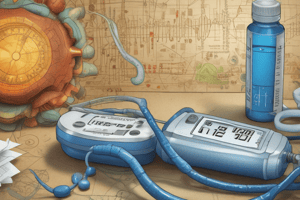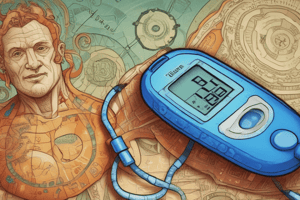Podcast
Questions and Answers
What is the primary aim of the Endocrine/Diabetes Practice at the University of Chicago?
What is the primary aim of the Endocrine/Diabetes Practice at the University of Chicago?
- Collect and discuss practical approaches to insulin dosing (correct)
- Investigate the causes of insulin resistance
- Conduct clinical trials to compare insulin regimens
- Develop alternative medications for diabetes management
What is the cornerstone of diabetes management?
What is the cornerstone of diabetes management?
- Insulin therapy (correct)
- Pancreas transplantation
- Dietary changes and exercise
- Medications that reduce insulin resistance
What is the goal of modern insulin dosing strategies?
What is the goal of modern insulin dosing strategies?
- To minimize short-term complications of diabetes
- To determine the optimal dosage for each individual patient
- To prove the noninferiority of one regimen to another (correct)
- To develop insulin regimens for specific patient populations
What is a common challenge in establishing glycemic targets?
What is a common challenge in establishing glycemic targets?
What is the primary limitation of clinical trials of insulin efficacy?
What is the primary limitation of clinical trials of insulin efficacy?
What has been demonstrated by well-conducted clinical studies over the past 25 years?
What has been demonstrated by well-conducted clinical studies over the past 25 years?
Which type of diabetes is more likely to be associated with lean patients?
Which type of diabetes is more likely to be associated with lean patients?
What is the primary goal of treatment for pregnant women with gestational diabetes or pre-existing diabetes?
What is the primary goal of treatment for pregnant women with gestational diabetes or pre-existing diabetes?
What is the effect of increased illnesses associated with weight gain on insulin requirements?
What is the effect of increased illnesses associated with weight gain on insulin requirements?
What is the effect of infection on glucose production?
What is the effect of infection on glucose production?
What is the risk of patients with type 1 diabetes during any illness?
What is the risk of patients with type 1 diabetes during any illness?
What is the effect of an increase in exercise on blood glucose in patients taking insulin secretagogues or using an insulin pump?
What is the effect of an increase in exercise on blood glucose in patients taking insulin secretagogues or using an insulin pump?
What is the purpose of the Total Daily Dose (TDD) in insulin dosing?
What is the purpose of the Total Daily Dose (TDD) in insulin dosing?
What is the benefit of starting with a conservative dose of insulin and gradually titrating the dose upward?
What is the benefit of starting with a conservative dose of insulin and gradually titrating the dose upward?
What is the primary consequence of following management algorithms or protocols indiscriminately?
What is the primary consequence of following management algorithms or protocols indiscriminately?
What is a crucial factor in insulin dosing, particularly in intensification of insulin regimens?
What is a crucial factor in insulin dosing, particularly in intensification of insulin regimens?
What is the current state of best practices for insulin dosing?
What is the current state of best practices for insulin dosing?
What is the main approach to determining the best insulin dose for the patient?
What is the main approach to determining the best insulin dose for the patient?
What is the purpose of a structured monitoring log in insulin therapy?
What is the purpose of a structured monitoring log in insulin therapy?
How often should patients on multiple dose insulin or continuous subcutaneous insulin infusion perform self-monitoring of blood glucose?
How often should patients on multiple dose insulin or continuous subcutaneous insulin infusion perform self-monitoring of blood glucose?
What is the benefit of simulation of insulin and blood glucose monitoring techniques?
What is the benefit of simulation of insulin and blood glucose monitoring techniques?
What is the purpose of teach-back and return demonstration in patient education?
What is the purpose of teach-back and return demonstration in patient education?
What is the ultimate goal of patient education in diabetes care?
What is the ultimate goal of patient education in diabetes care?
What is essential for improving diabetes care in the face of the diabetes epidemic?
What is essential for improving diabetes care in the face of the diabetes epidemic?
What is the correlation between A1C and the frequency of self-monitoring of blood glucose?
What is the correlation between A1C and the frequency of self-monitoring of blood glucose?
What is the primary challenge in diabetes care in the face of the diabetes epidemic?
What is the primary challenge in diabetes care in the face of the diabetes epidemic?




